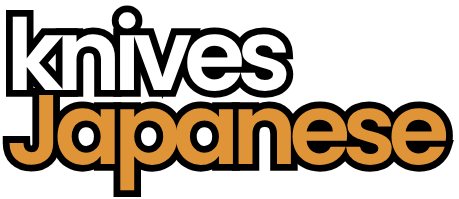The allure of the samurai, an iconic figure in Japanese history, extends far beyond their martial prowess and ethical code. Central to their identity and combat effectiveness were their exquisite blades, particularly what we commonly refer to as japanese samurai knives. These formidable instruments were not merely weapons; they were symbols of status, expressions of master craftsmanship, and sometimes, tools for the most solemn of rituals.
Delving into the world of these specialized blades reveals a rich tapestry of history, metallurgy, and profound cultural significance. Understanding the true nature of japanese samurai knives requires moving beyond popular misconceptions and appreciating the nuanced roles they played in samurai life. From the battlefield to the tea ceremony, these knives held a unique and indispensable position.
The Enduring Mystique of Japanese Samurai Knives
Beyond the Katana: Defining the True “Samurai Knife”
When most people envision a samurai’s arsenal, the powerful katana immediately comes to mind. While the katana was undoubtedly the primary long sword, it was often accompanied by shorter, equally vital blades. These shorter blades, often grouped under the umbrella term of japanese samurai knives, served distinct purposes that the katana could not fulfill.
The term “samurai knife” is somewhat broad, encompassing several specific types of blades used by the samurai class. These included the tanto, the yoroidoshi, and sometimes even smaller utility knives like the kogatana. Each of these blades had its unique design, function, and place within the samurai’s daily life and martial practice.
It is crucial to differentiate these blades from everyday kitchen knives or general utility tools, as their design and construction were specifically tailored for martial or ceremonial use by the warrior class. The precision and artistry involved in creating these japanese samurai knives rivaled that of their longer counterparts.
A Legacy Forged in Steel, Culture, and Combat
The legacy of japanese samurai knives is deeply intertwined with the history of feudal Japan. These blades were not mass-produced commodities; each was a meticulously crafted work of art, infused with the spirit and skill of the smith. The techniques used to forge these knives were often closely guarded secrets, passed down through generations of master blacksmiths.
Beyond their practical application in combat, these knives were imbued with significant cultural meaning. They were often passed down through families, serving as heirlooms and symbols of ancestral honor. The reverence with which samurai treated their blades reflected the profound respect for the craftsmanship and the role these tools played in their existence.
The very essence of the samurai spirit, characterized by discipline, honor, and martial prowess, is mirrored in the design and purpose of japanese samurai knives. They represent a tangible link to a bygone era, offering insights into the complex world of Japan’s warrior elite. To truly understand the samurai, one must appreciate the intricate details of their entire blade collection.
The Ancient Origins and Evolution of Japanese Samurai Knives
Early Blades: From Utility to Warrior’s Companion
The origins of what would eventually become distinct japanese samurai knives can be traced back to practical tools and early forms of weaponry. Before the emergence of the samurai class in its recognizable form, various types of short blades were used for hunting, utility, and self-defense. These early knives laid the groundwork for the more specialized weapons that would follow.
As organized warfare became more prevalent in Japan, the need for specialized close-quarter weapons grew. Early blades were often straightforward, functional tools, but gradually, refinements in metallurgy and design began to transform them. The focus shifted from mere utility to efficiency in combat, particularly in confined spaces or as a last resort.
It was during this period that the conceptualization of a “companion blade” to a longer sword began to take shape. While not yet the distinct tanto or yoroidoshi, these early iterations represented the embryonic forms of japanese samurai knives designed for a warrior’s specific needs. Their evolution was a direct response to changing battlefield dynamics and martial techniques.
The Heian and Kamakura Periods: Birth of Distinct Forms
The Heian period (794-1185) saw the rise of the samurai as a distinct social class, and with it, the standardization and refinement of their weaponry. While the focus was largely on the development of the tachi (the precursor to the katana), shorter blades also began to evolve into more recognizable forms. The need for a versatile sidearm became increasingly apparent.
It was in the subsequent Kamakura period (1185-1333) that the tanto, arguably the most iconic of japanese samurai knives, truly came into its own. This era was characterized by frequent warfare, demanding robust and effective close-combat weapons. Tanto blades from this period are highly prized for their strength, craftsmanship, and simple yet effective designs.
These early tanto were often sturdy, straight, or slightly curved blades, designed for thrusting and close-quarters fighting. They were an indispensable part of the samurai’s equipment, offering a crucial advantage when a longer sword was impractical. The Kamakura period firmly established the tanto as a primary type of japanese samurai knives.
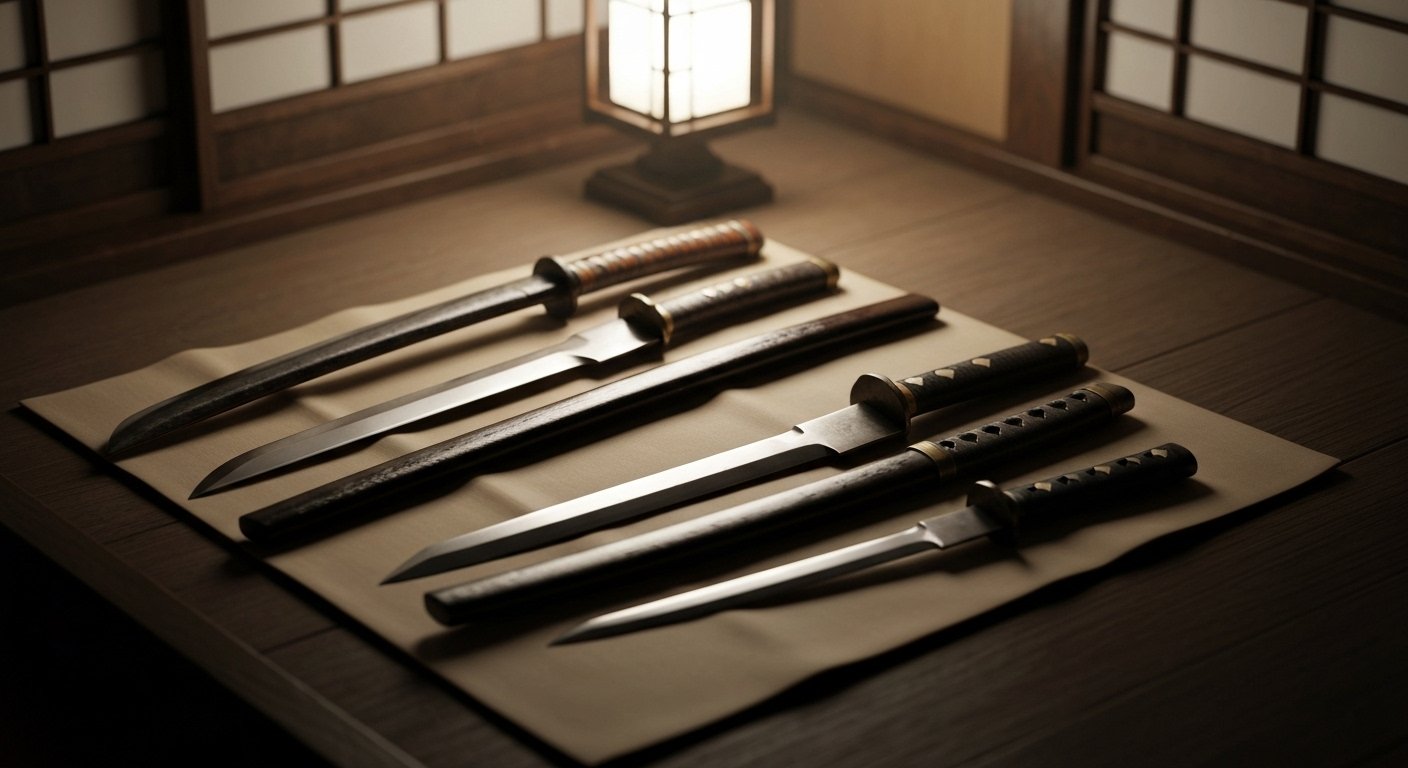
Adapting to Warfare: Sengoku Era Innovations in Japanese Blades
The Sengoku period (1467-1615), often called the “Age of Warring States,” was a time of relentless conflict and immense innovation in Japanese warfare. This intense period further refined the design and utility of japanese samurai knives, adapting them to the evolving battlefield and fighting styles. The sheer volume of combat necessitated practical and durable weapons.
During the Sengoku Jidai, the tanto continued to be a staple, but its design diversified, with varying lengths and blade profiles emerging to suit different preferences and combat situations. The development of more sophisticated armor also spurred the creation of blades specifically designed to penetrate it, such as the yoroidoshi.
The emphasis during this era was on efficiency and reliability. While aesthetic appeal was always a factor, the primary concern was performance in life-or-death situations. This practical focus led to robust construction and specialized features in japanese samurai knives, ensuring they were effective tools for warriors navigating a perpetually violent landscape. For more on the historical context of these remarkable tools, you might explore our section on the history of Japanese knives.
Deconstructing the Core Japanese Samurai Knives: Tanto, Yoroidoshi, and Kogatana
The Tanto: A Dagger of Both Practicality and Protocol
The tanto is undoubtedly the most well-known of all japanese samurai knives. This short sword or dagger, typically ranging from 15 to 30 centimeters (6 to 12 inches) in blade length, was a versatile tool. Its primary function was as a stabbing weapon, especially effective in close-quarters combat or when a samurai had lost their longer sword.
Beyond its martial applications, the tanto held significant ceremonial importance. It was often carried in daily civilian life as part of a samurai’s attire, even when the katana was not. It could be worn openly or concealed within the obi (sash), signifying the samurai’s readiness and status. The tanto’s design varied widely, from slender and elegant to broad and robust.
The craftsmanship of a tanto often paralleled that of a katana, featuring a visible hamon (temper line) and expertly fitted koshirae (mountings). Its presence completed the daisho, the traditional pairing of a long sword and a short sword, symbolizing the samurai’s dual identity as a warrior and a gentleman. The tanto, among japanese samurai knives, embodies both lethal practicality and refined protocol.
Yoroidoshi: The Armor-Piercing “Knife” and Its Brutal Purpose
The yoroidoshi, literally “armor piercer,” represents a highly specialized type of japanese samurai knives. Unlike the versatile tanto, the yoroidoshi was designed with a singular, brutal purpose: to penetrate armor. These blades are typically thick, robust, and often have a steeply angled or “chisel” tip (kiriba or hira-zukuri blade geometry) to maximize piercing power.
During pitched battles, samurai wore formidable lamellar armor, which offered excellent protection against slashing attacks. However, gaps existed at the joints, under the arms, or at the helmet’s gorget. The yoroidoshi was crafted to exploit these weaknesses, delivering fatal thrusts into armored opponents where a conventional blade might fail.
Yoroidoshi blades tend to be shorter and stouter than most tanto, emphasizing strength over elegance. Their construction often involved a robust core and a very sharp, reinforced tip, making them ideal for the grim task of finishing off armored foes or for close-in grappling. This specialized blade highlights the brutal realities of ancient Japanese warfare and the ingenious adaptations in japanese samurai knives.
Kogatana and Kozuka: The Everyday Utility and Artistic Side of the Samurai
While the tanto and yoroidoshi were undeniably martial, other smaller blades were also considered japanese samurai knives, albeit for more mundane purposes. The kogatana, a small utility knife, was often carried in a slot on the scabbard of a katana or wakizashi. It was typically housed within a kozuka, which was the handle for the kogatana, often intricately decorated.
The kogatana itself was a simple, single-edged blade, used for a myriad of daily tasks: sharpening pencils, cutting string, opening letters, or even preparing food. It was the samurai’s equivalent of a pocket knife, reflecting the practical aspects of their lives outside of combat. Despite its utilitarian purpose, the kogatana was still a blade carried by a samurai, thus bearing a certain degree of status.
The kozuka, on the other hand, was frequently a canvas for artistic expression. Elaborate designs, family crests, or symbolic motifs were often inlaid or carved into the metal handle. This showcased the samurai’s personal aesthetic and their appreciation for fine craftsmanship, even in the smallest of their possessions. These smaller japanese samurai knives demonstrate the blend of utility and artistry inherent in samurai culture.
The Artisanal Secrets: Crafting the Legendary Japanese Samurai Knives
Tamahagane and Shingane: The Foundation of Superior Steel
The unparalleled quality of japanese samurai knives begins with the steel itself. Traditional Japanese blades are forged from tamahagane, a specialized steel smelted in a traditional tatara furnace. This process involves heating iron sand and charcoal over several days, resulting in a steel with varying carbon content and distinct properties.
Tamahagane is not homogeneous; it contains both high-carbon sections (for the edge) and lower-carbon sections (for the core). This variability is crucial for the differential hardening process. The smith carefully selects and separates these different grades of steel, understanding their unique characteristics and how they will contribute to the final blade.
To create a resilient and sharp blade, multiple layers of steel are forged together. The shingane, or core steel, is typically softer and more flexible, absorbing shock and preventing breakage. The kawagane, or skin steel, is harder and provides the cutting edge. This complex lamination process is fundamental to the strength and durability of japanese samurai knives, setting them apart from simpler European blades. For an in-depth look at materials, check out our guide on knife materials.
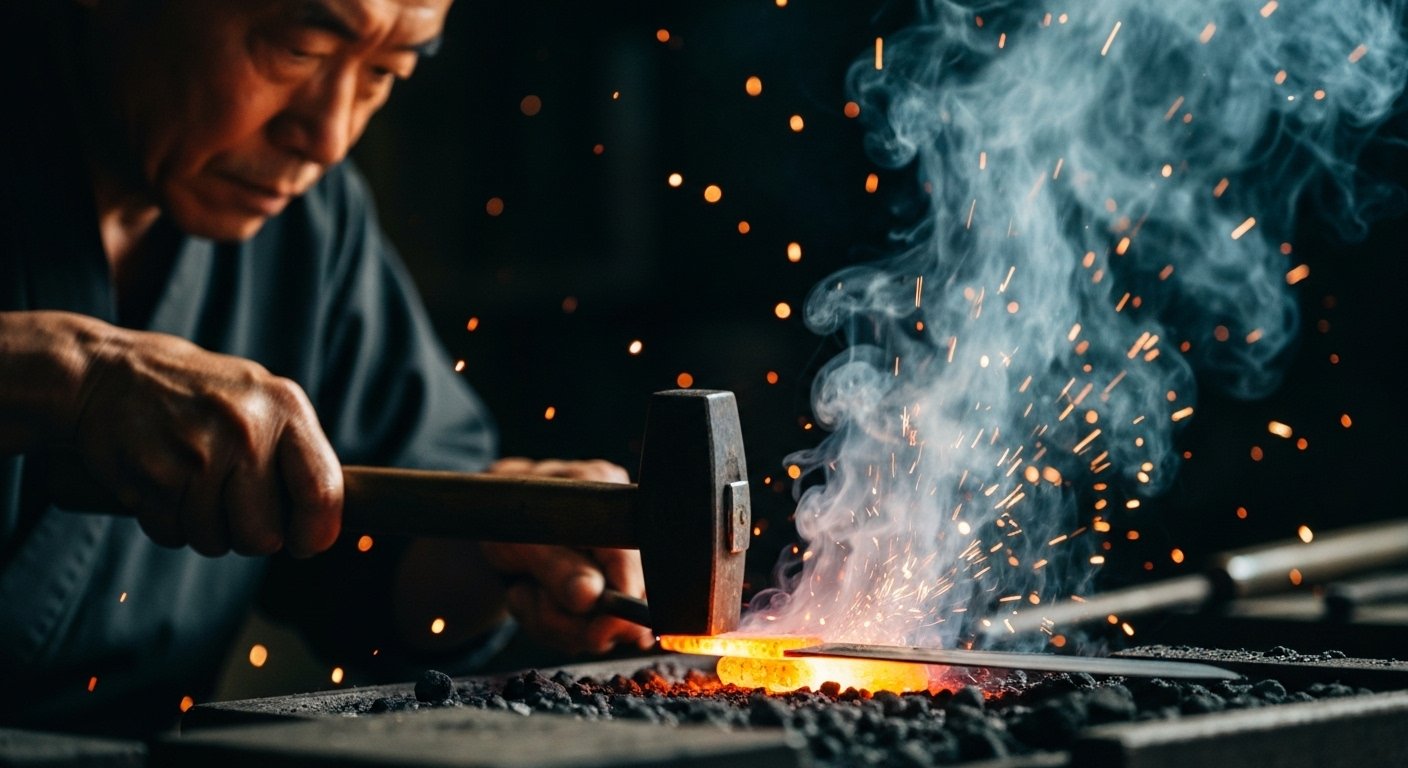
Forging and Differentially Hardening: The Creation of the Hamon
The forging process for japanese samurai knives is a meticulous and labor-intensive endeavor. The chosen pieces of tamahagane are repeatedly heated, hammered, and folded, removing impurities and creating thousands of layers of steel. This layering process strengthens the metal and distributes the carbon evenly throughout the blade, preparing it for the differential hardening.
Differential hardening is the hallmark of traditional Japanese blade making, and it is what gives these knives their unique properties and the beautiful hamon. Before quenching, the smith applies a special clay mixture to the blade, varying its thickness along the spine and edge. The thicker clay on the spine insulates it, causing it to cool slower, while the thinner clay (or no clay) on the edge allows it to cool rapidly.
When the hot blade is plunged into water, the rapid cooling of the edge transforms its crystalline structure into martensite, making it incredibly hard and capable of holding a razor-sharp edge. The slower cooling spine remains softer and more flexible, absorbing impact and preventing the blade from shattering. This process creates the distinct hamon, a visible temper line that follows the boundary between the hard edge and the softer spine, making each of these japanese samurai knives a unique piece of art.
Koshirae and Habaki: The Art and Function of Blade Mountings
While the blade itself is the soul of a japanese samurai knife, its koshirae, or mountings, are equally vital. Koshirae refers to all the fittings that adorn the blade, including the handle (tsuka), guard (tsuba, though less common on smaller knives), scabbard (saya), and various decorative elements. These components are not merely aesthetic; they provide critical functionality and balance.
The tsuka is wrapped with ito (braid) over ray skin (samegawa), providing a firm, non-slip grip. The materials and wrapping style often reflected the samurai’s personal taste and status. The saya protects the blade when not in use and is typically made of wood, often lacquered and sometimes decorated with intricate designs.
A crucial, often overlooked component is the habaki. This metal collar fits snugly around the base of the blade, securing it within the saya and ensuring a proper fit. It also prevents moisture from entering the scabbard, protecting the blade from rust. The habaki, though small, is essential for the longevity and functionality of japanese samurai knives, demonstrating the meticulous attention to detail in every aspect of their creation.
Symbolism and Ritual: The Cultural Significance of Japanese Samurai Knives
The Role of Tanto in Seppuku: Honor and the Final Act
Perhaps the most somber and significant ritual associated with japanese samurai knives is seppuku, or ritual suicide. For a samurai, losing honor was often considered worse than death. Seppuku offered a way to restore one’s honor, atone for a mistake, or avoid capture and torture by an enemy.
While a wakizashi (a short sword) could also be used, the tanto was frequently the blade of choice for seppuku. Its compact size made it suitable for the prescribed ritual, which involved a deep cut across the abdomen. The act was performed with solemn dignity, often in front of witnesses, and was a profound demonstration of the samurai’s unwavering commitment to their code of bushido.
The tanto’s role in seppuku underscores the deep connection between japanese samurai knives and the samurai’s concept of honor and duty. It was a tool that facilitated the ultimate act of self-sacrifice, transforming a simple blade into an instrument of profound spiritual significance. This ritual highlights the intensity of the samurai worldview.
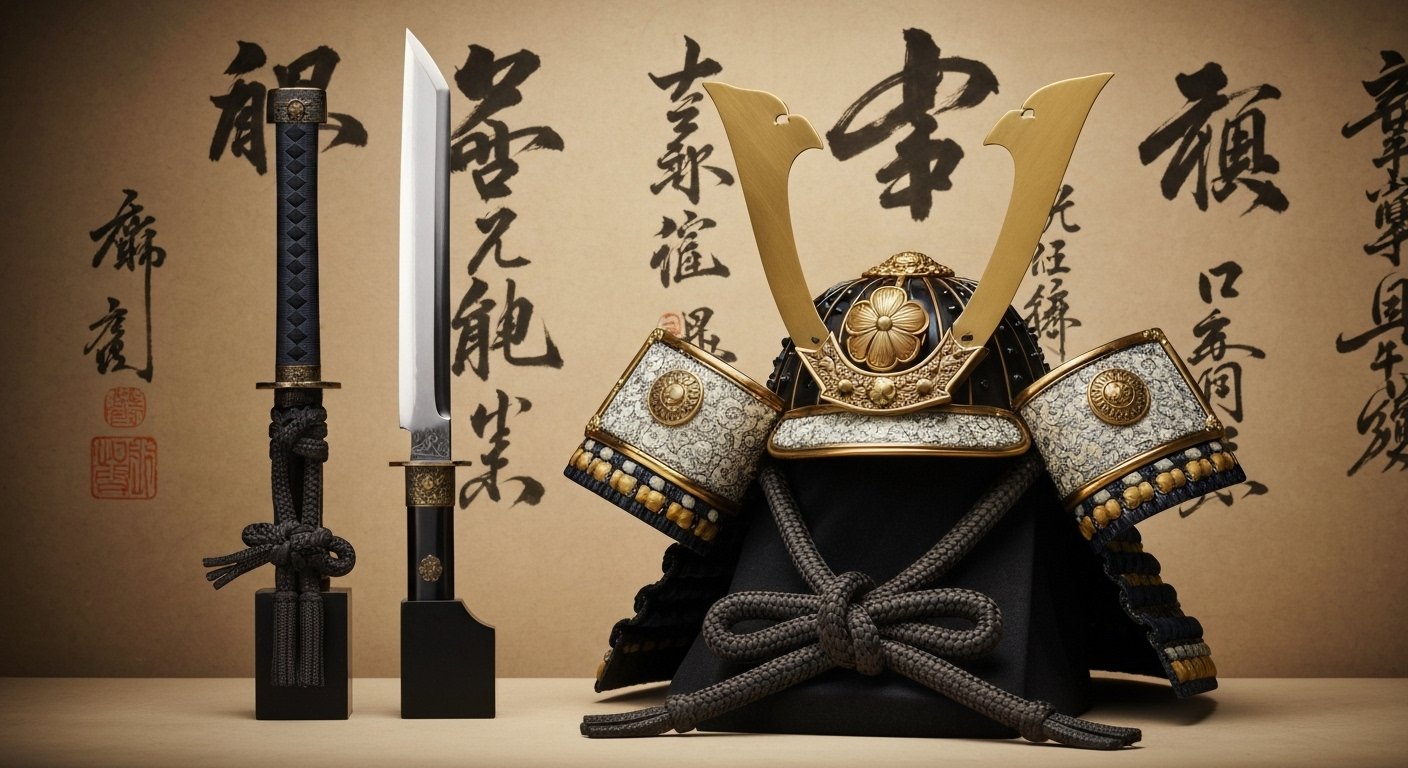
Daisho: The Paired Blades and Their Representation of Rank
The daisho, meaning “big-small,” refers to the iconic pairing of a samurai’s two swords: the longer katana (or tachi) and the shorter wakizashi. While a tanto could sometimes replace the wakizashi as the shorter blade, the concept of carrying paired swords was a defining characteristic of the samurai class. This pairing was more than just a practical arrangement of weapons.
The daisho was a clear symbol of a samurai’s rank, status, and privilege. Only samurai were permitted to wear both swords, instantly identifying them as members of the warrior elite. The longer sword was for open combat, while the shorter one was for close quarters, indoor fighting, or as a backup weapon. The unity of the two blades represented the samurai’s dual responsibilities in both war and peace.
The scabbards and fittings of the daisho were often designed to match, creating a harmonious aesthetic that further emphasized their symbolic unity. Owning and wearing a well-crafted daisho, including its constituent japanese samurai knives, was a source of immense pride and a visual representation of the samurai’s identity and power within feudal Japanese society.
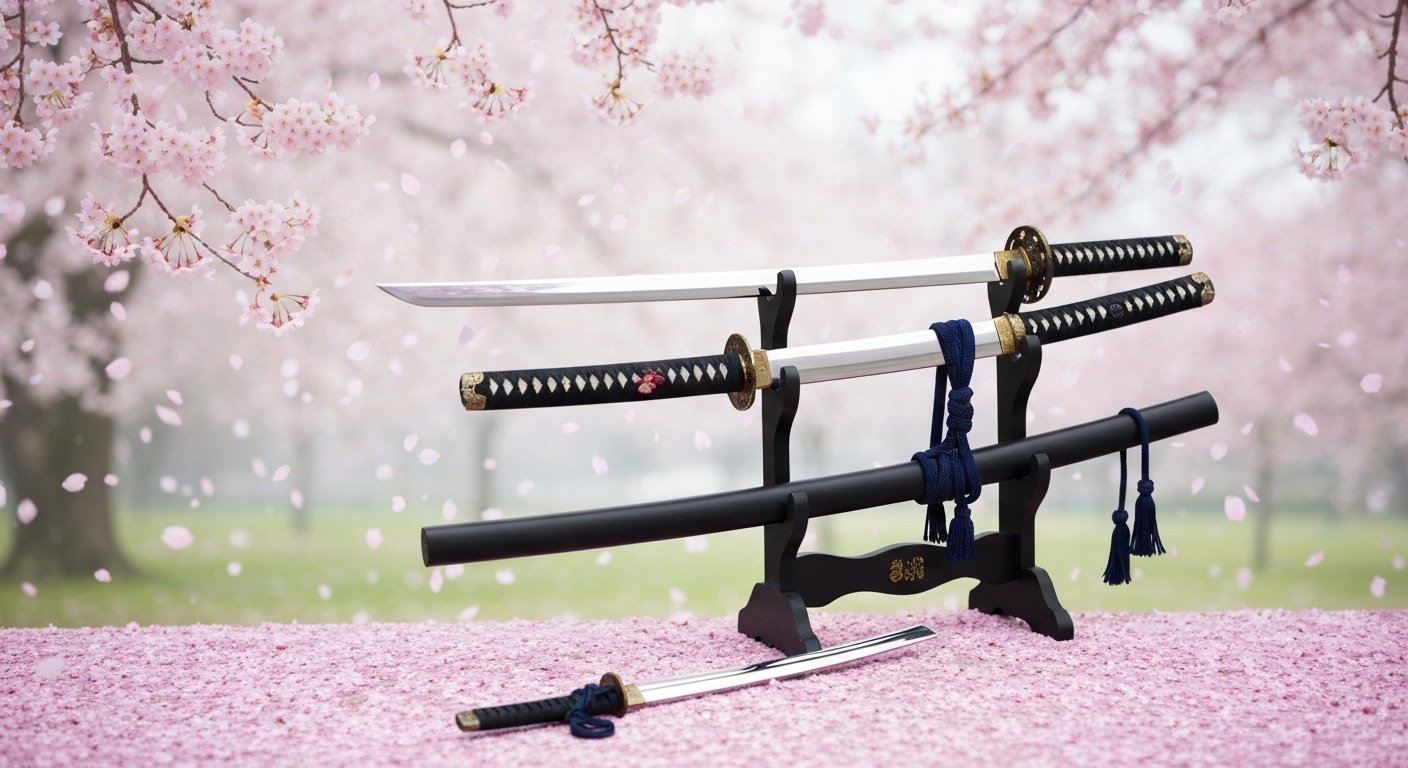
Symbolic Meanings in Engravings, Fittings, and Handle Wraps
Every element of japanese samurai knives, from the blade itself to its intricate mountings, often carried symbolic meaning. Engravings on the blade, known as horimono, could depict deities, mythical creatures, or Buddhist prayers, believed to offer protection or bestow good fortune upon the wielder. These carvings were not merely decorative but deeply spiritual.
The metal fittings (kodogu) that adorned the handle and scabbard – such as the tsuba (if present), fuchi (collar), kashira (pommel), menuki (ornaments under the handle wrap), and kozuka (for the kogatana) – were miniature works of art. These pieces were often crafted from precious metals like gold, silver, and shakudo (an alloy of copper and gold) and featured elaborate motifs.
Common motifs included dragons, tigers, cherry blossoms, chrysanthemums, or scenes from Japanese mythology and history. Each of these symbols had specific connotations, representing courage, longevity, purity, or prosperity. Even the intricate patterns of the handle wrap (tsuka-maki) held aesthetic and sometimes symbolic significance, reflecting the attention to detail that permeates the creation of japanese samurai knives.
The Unseen Truths: Debunking Myths and Understanding Authenticity in Japanese Samurai Knives
Distinguishing Genuine Antique Blades from Modern Replicas
In the vast market for Japanese blades, distinguishing a genuine antique japanese samurai knife from a modern replica can be a significant challenge for the uninitiated. Authentic blades are historical artifacts, often hundreds of years old, displaying unique characteristics that cannot be perfectly replicated by contemporary mass production methods.
Key indicators of authenticity include the presence of a true hamon (often visible as a distinct pattern in the steel due to differential hardening, not simply etched on), the specific grain pattern of the folded steel (hada), and the quality of the forging work. Examination of the tang (nakago), where the smith’s signature (mei) might be found, is also crucial. Authentic tangs show signs of age and patina.
Modern replicas, while sometimes beautiful and well-made, often lack the subtle nuances of hand-forged antiques. Their steel might be monosteel, their “hamon” might be acid-etched, and their fittings might lack the intricate detail and aged patina of historical pieces. Consulting a reputable expert or a certified nihonto (Japanese sword) appraiser is essential when considering the purchase of genuine japanese samurai knives. Learn more about identifying quality in our best Japanese knives guide.
The Perils of Misinformation: Common Fables About Samurai Blades
The mystique surrounding japanese samurai knives has given rise to numerous myths and exaggerations. One pervasive myth is that a katana or tanto could “cut through anything” or “cut through a machine gun barrel.” While these blades were incredibly sharp and strong for their time, they were still made of steel and subject to the laws of physics.
Another common misconception is that all Japanese blades are indestructible. While designed for resilience, they can chip, bend, or break under extreme stress, especially if improperly used or cared for. Tales of blades being folded a million times are also exaggerated; while folding did occur thousands of times, the “million” figure is a hyperbole. The folding process served to refine the steel and distribute carbon, not just to add layers for their own sake.
Understanding the true capabilities and limitations of these historical weapons is vital for appreciating their engineering marvel without falling prey to sensationalized lore. Responsible enthusiasts should seek accurate information from scholarly sources and reputable experts to truly understand japanese samurai knives and their real history.
Ethical Collecting and Responsible Ownership of Historical Japanese Samurai Knives
Collecting historical japanese samurai knives is a rewarding pursuit, but it comes with a significant responsibility. Ethical collecting means ensuring that the blades are legally acquired, respecting their cultural heritage, and understanding their provenance. Supporting the illicit trade of artifacts harms cultural preservation and is illegal.
Responsible ownership involves proper care and preservation of these valuable artifacts. Antique blades are susceptible to rust and damage if not maintained correctly. This includes regular oiling, careful handling, and storing them in appropriate conditions to prevent environmental degradation. Collectors should also educate themselves on the proper handling and display of such items.
Furthermore, responsible ownership entails understanding the legal frameworks surrounding historical weapons in one’s region. Many countries have strict regulations regarding the ownership and display of antique swords and knives. By adhering to ethical guidelines and responsible practices, collectors can ensure that the legacy of japanese samurai knives is preserved for future generations, honoring their historical and artistic significance. Proper knife care and sharpening techniques are crucial, even for historical pieces if they are to be maintained in their original condition (though sharpening antiques is rarely recommended).
The Unyielding Edge of Japanese Samurai Knives
A Comprehensive Look at Their Past, Craft, and Cultural Resonance
The journey through the world of japanese samurai knives reveals far more than just sharp edges and intricate designs. It is a profound exploration into the heart of samurai culture, a testament to unparalleled craftsmanship, and a chronicle of historical evolution. From the rudimentary tools of early Japan to the highly specialized blades of the Sengoku period, these knives adapted and diversified.
We’ve uncovered how essential blades like the tanto served as both practical weapons and ceremonial symbols, while the yoroidoshi demonstrated a brutal, purpose-driven innovation for warfare. The smaller kogatana highlighted the blend of utilitarianism and art that permeated even the most modest of a samurai’s possessions. The secret lies not just in their form but in their function and the context of their use.
The deep cultural resonance of japanese samurai knives is evident in their role in rituals like seppuku, their status as part of the iconic daisho, and the rich symbolism embedded within every engraving and fitting. These blades are not inanimate objects; they are storytellers, echoing the values, beliefs, and artistic prowess of a legendary warrior class.
Preserving the Legacy for Future Generations of Enthusiasts and Historians
The legacy of japanese samurai knives is a precious one, deserving of careful preservation and accurate understanding. It is vital to continue research into their history, metallurgy, and cultural impact, ensuring that myths are debunked and genuine knowledge prevails. This allows enthusiasts and historians alike to appreciate these artifacts for what they truly are: masterpieces of engineering and art.
Through responsible collecting, meticulous care, and a commitment to education, we can ensure that these remarkable blades continue to inspire awe and curiosity. They offer invaluable insights into the martial arts, metallurgy, and societal structures of feudal Japan. The enduring appeal of japanese samurai knives is a testament to the ingenuity and discipline of their creators.
As we look to the future, the continued study and appreciation of these historical blades will undoubtedly deepen our understanding of a pivotal era in Japanese history. They stand as enduring symbols of an unyielding spirit, a testament to the power of human ingenuity, and a bridge connecting us to the ancient world of the samurai. Their edge, both literal and metaphorical, remains unyielding.
Explore more fascinating insights into the world of Japanese blades and culture:
